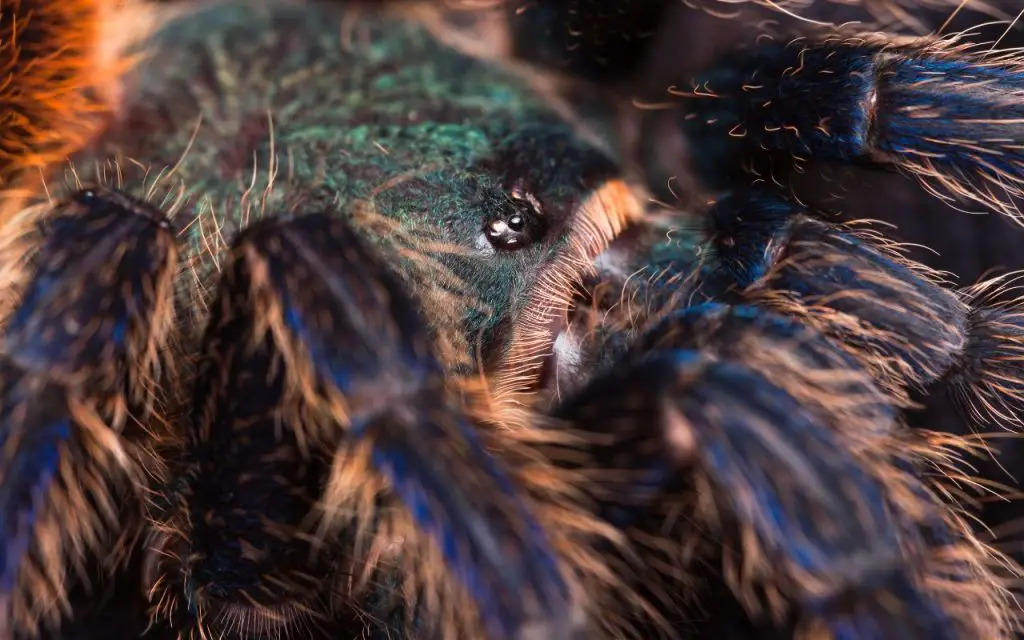Last updated on February 1st, 2023 at 10:05 am
How far can tarantulas see? Whilst they are undoubtedly powerful predators, their eyesight isn’t that great – keep reading to learn more…
If you’ve ever wondered how far tarantulas can see, then you’re not alone. You’re probably wondering: Do tarantulas have night vision? Do they prefer the dark? And where are their eyes located? Read on to discover the answers to these questions and more. In addition, we’ll discuss why tarantulas prefer the dark over bright sunlight.
Tarantula vision
While are relatively primitive creatures, they do have many eyes. Their eyes, however, do not provide them with very good vision.
Besides seeing light, tarantulas rely on their other senses to help them navigate their surroundings. Nevertheless, they do have many eyes and a wide field of vision. Let’s explore some of these differences in Tarantula vision to better understand how they navigate.
Unlike most other animals, tarantulas have eight eyes. They use these eyes to guide them towards their safe habitat, which is usually dark. These eyes are also important for a Tarantula’s circadian rhythm, which changes as the amount of light increases and decreases.
Therefore, these venomous creatures use their eyes to detect food and possible predators. While we cannot fully understand what it’s like to be them, we can tell that sight isn’t their only sense – or perhaps even the most imporant one to them.

Do tarantulas have night vision?
While it may seem like tarantulas have perfect vision, the reality is that their eyesight is far less developed. It’s main purpose is to detect light, or the dark outline of a predator. While light does not harm them, it may send them running for cover.
The majority of tarantulas are nocturnal, which means they only hunt at night. While their primary eyes are used for color vision and binocular vision, their secondary eyes are used to scan a wide range of objects in black and white.
The secondary eyes are also located on the side of the head, which gives them 360-degree vision. The primary eyes are mainly responsible for detecting food, while the secondary eyes are mostly for detecting threats.
As far as we know, tarantulas do not have night vision. Moreover, they don’t really need it. They’re perfectly capable of using the sense of touch and vibrations for pinpoint prey that wanders past them. The limited eyesight they have is nonetheless useful for detecting predators and light vs dark.

Do tarantulas prefer the dark?
Many people wonder if tarantulas prefer the dark. In fact, tarantulas will always choose the darkest place possible to hide. If given the choice, they will head towards the darkest area around them (this makes it easier to find one if it escapes!).
It’s not entirely clear what makes them prefer the dark. Some scientists have speculated that this is because they have evolved their colour vision to be more vibrant than in daylight. This theory is counterproductive in some ways, because tarantulas are crepuscular and are able to see colours in dim light.
What is clear is that dark areas are usually synonomous with increased humidity, less chance of predator and more stable temperatures. It is probably the innate survival instincts of tarantulas that guide them to these places.
It’s also worth noting that tarantulas are highly sensitive to bright or hot light. In captivity, you should always avoid placing them somewhere where they could be exposed to direct sunlight. You should also avoid using heat lamps, as these can dehydrate and kill a tarantula incredibly quickly.

Where are tarantulas eyes located?
If you’re wondering, “Where are tarantulas eyes located?” you’re not alone. Tarantulas are highly sensitive creatures. Their sensory hairs (called setae) and pedipalps pick up vibrations and chemical cues.
These organs help the tarantula discern between sounds and chemicals from predators or prey. That’s how they can catch prey that is not visible to the human eye.
In addition to these sensory organs, the tarantulas eyes are located on a turret-like structure on top of their cephalothorax. The cephalophorax is a body segment consisting of a conjoined head and thorax. Having the eyes placed on top of this gives the spider an excellent way of detecting changes in light.
While you may wonder why the tarantula has so many eyes, they are actually quite limited. These spiders can see ok(ish), but they can’t see everything either. It is actually quite surprising how small and underdeveloped their eyes are.
Their eyesight isn’t as sophisticated as ours, but it is still incredibly helpful for survival. Without them, they would be unable to see the world around them.

Why do tarantulas have eight eyes?
The reason why tarantulas have eight eyes is unknown, but there are a few theories about why. Namely, spiders do not have complex eyes, so it makes sense to have more than one. This is why some insects have compound eyes, for example.
The reason that tarantulas have eight eyes is probably because their vision is simple and they cannot make sharp images. That said they do need to detect light, movement, and shape. If you only have very simple eyes, then the more the better. Tarantula eyes are also very small, so have more is easy, and doesn’t cost the spider a lot more, energetically speaking.
Their eyes are relatively small and do not have an impressive field of view, but they can detect light and movement. Having eight eyes pointing in different directions allows them to perceive threats – like the looming shadow of a predator against the moonlight – more easily.







